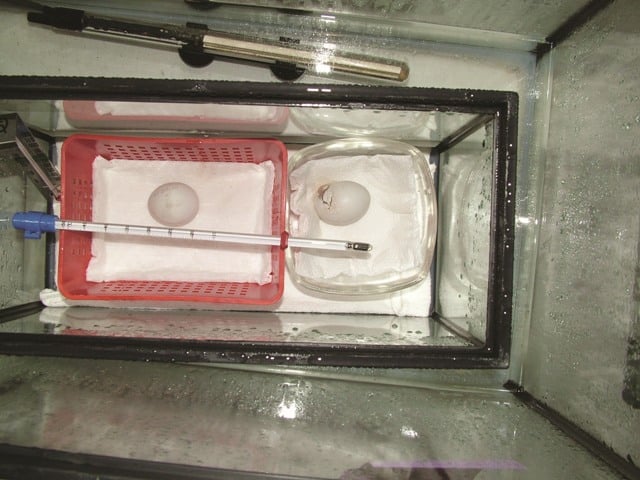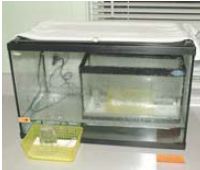
Setting Up a Nursery Water Brooder
The HARI Aqua Brooder

This system has been successfully used at the HARI for many years. In order to provide the ideal environment for the hatching process and neonatal care, a system using wet-bulb heating was assembled using articles already available and manufactured for the pet market.
Having a heat source generated by heated water provides the humidity necessary for the hatching process. Artificially incubated eggs are removed from the incubator after the first sign of pipping is observed and the rest of the hatching process takes place in this unit.
In order to achieve the desired humidity and temperature, a towel is placed over the unit and can be adjusted to maintain the temperature & humidity desired. This unit also provides greater chances of success when forced to intervene and assist the hatching process. When the developmental stage of the egg reaches draw down and the egg starts the pipping process, transfer to this unit is ideal. If left in the incubator along with other eggs, the turning mechanism cannot be stopped, nor can you risk opening the incubator frequently to closely monitor the hatching process; temperature and humidity fluctuation could endanger the viability or development of the other eggs. Have an aqua brooder installed and operating at all times so that you are ready for the neglected parent raised chick, unexpected hatching or assist hatching intervention.
 In order to maintain the desired temperature the chicks are placed in the floating 2.5 gal. aquarium inside of a smaller container. It is essential to monitor the temperature within the floating aquarium in order to have the accurate reading of the chicks’ environment.
In order to maintain the desired temperature the chicks are placed in the floating 2.5 gal. aquarium inside of a smaller container. It is essential to monitor the temperature within the floating aquarium in order to have the accurate reading of the chicks’ environment.
This dual-purpose unit also serves as an ideal nursery for neonates. The environment provides the humidity required to maintain proper hydration of neonates, essential to ensure digestive motility and absorption.
Some Advantages:
- This unit offers superior humidity directly surrounding the chicks. The removable glass door on the front panel of the terrarium allows the humidity generated by the heated water below to have direct contact with the chicks environment.
- Another advantage is that the blanket no longer needs to be removed to have access to the chick. It used to be difficult to monitor and maintain the perfect temperature when the blanket would get moved every time we had to monitor or feed the chick. The positioning of the blanket plays a crucial role in maintaining the perfect environment.
- The size of this unit easily accommodates 2 chicks at once.
Required Materials:
• 10 gal. Aquarium
• 2.5 or 5 gal aquarium
• Thermal Compact completely submersible aquarium heater
• ¼ cup of Safety salt
• Thermometer
• Hydrometer
• Towel
• Rigid plastic container
• Screen top (terrarium)
Precautions
- Monitor the water level to prevent the floating aquarium within from tipping over. The water level should be barely an inch above the water heater.
- ¼ cup of Safety Salt added to the water will prevent bacteria from growing in this unit, although we recommend the unit be dismantled every week, disinfected and dried in the sunlight to rid any bacterial formations none the less. HARI is presently testing the use of natural liquid bleach in highly diluted concentrations and Oxyfresh for a more effective bacterial growth inhibitor.
- The size of the interior floating aquarium will depend on the size and species kept in this unit. When the hatchling is a few days old, we place a small towel or stuffed animal in the aquarium so that he can lean up against or snuggle up to it. Make sure the inside aquarium in not too restraining. Replace with the 5 gal. aquarium to allow the chick to be kept in this unit longer.
- The aquarium water heater should not be exposed to the air. Read instructions carefully. Always maintain a minimum of water over the installed heater. Water will quickly evaporate!
- Maintaining a stable temperature and humidity will be easier to achieve if the unit is placed in a small nursery room, where minimal heat fluctuations are present. Do not place under an air vent. Set up the unit in advance and take a day or 2 to monitor and record the temperature and humidity at different times throughout the day.
- Keep records of temp. & humidity, fluctuations, growth charts, and general observations for further reference.
- Refer to manuals such as Rick Jordan’s Parrot Incubation Procedures for recommended temperature and humidity within the brooders.
Gradually decrease and adjust the ambient temp, as the chick ages. This unit can house neonates for the first 10 days depending on the species. Beware of extreme temperatures, which will cause panting and hyperthermia in the chicks.


